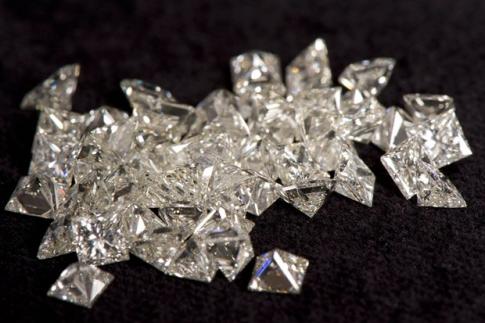Quantum paradox seen in diamond

A quantum effect named after an ancient Greek puzzle has been observed in diamond, paving the way for the use of diamond crystals in quantum computer chips.
Eugenie Samuel Reich
A quantum effect named after an ancient Greek puzzle has been observed in diamond, paving the way for the use of diamond crystals in quantum computer chips.
The quantum Zeno effect gets its name from the Greek philosopher Zeno of Elea, who lived in the fifth century bc and suggested that if the position of a flying arrow is well-defined for a moment of time, then it makes no progress in that moment, and so can never reach its destination.
In the quantum version of the arrow paradox, theoretical physicists posited in 1977 that if a quantum system is measured often enough, its state will be unable to progress, as if it were true that 'a watched pot never boils'. The hypothesis arises from a fundamental postulate of quantum theory, which says that measuring a property of an object, such as its position, affects its state. The quantum Zeno effect was first observed experimentally in 1989 in laser-cooled ions trapped by magnetic and electric fields1.
Now, quantum physicist Oliver Benson and his colleagues at Humboldt University in Berlin have seen the effect in a diamond crystal — a material that would be easier to manufacture on a large scale for quantum computing. The team posted its paper on the arXiv2 and it has been accepted for publication in Physical Review A.
Disrupted oscillations
The researchers focused on nitrogen–vacancy (NV) centres, imperfections in diamond that arise where an atom of nitrogen and an empty space replace carbon atoms at two neighbouring spots in the crystal lattice. The team used microwaves to change the magnetic spin state of an electron located at an NV centre, and then used a laser beam to trigger red fluorescence that revealed which of two possible states the electron was in at any given moment. When they measured the NV centre in this way, the researchers found that the oscillation between the two states was disrupted — just as would be expected if the quantum Zeno effect were operating.
“The first step is to see the effect is there, but the next step is to implement quantum gates based on diamond,” says Benson, referring to the quantum analogue of the logic gates that form the integrated circuits in ordinary computer chips. In quantum computing, information is stored in the quantum states of carriers such as photons or diamond defects. But so far, decoherence, a degradation of the delicate states caused by noise in the environment, has prevented researchers from storing more than a few bits of linked quantum information in a diamond crystal at a time. Constantly measuring the states could protect them from uncontrolled decay and allow researchers to scale up the amount of information stored, says Benson.
Ronald Walsworth, an atomic physicist at Harvard University in Cambridge, Massachusetts, whose team made a tentative suggestion in 2010 that the quantum Zeno effect operates in diamond3, says that evidence is growing, but that it will probably need to be clearer that the disruption of oscillations is due to the quantum process, and not other effects, before it can be used for quantum computing.
Quantum physicist Ronald Hanson, who works with nitrogen vacancies at Delft University of Technology in the Netherlands, says that Benson's experiment, together with an April paper4 showing that spins in NV centres located 3 metres apart can be linked, indicates that diamond is gaining ground as a convenient material for quantum computing. “In a few years, we will be overtaking the ion traps,” he says. /Nature




 del.icio.us
del.icio.us Digg
Digg

Post your comment